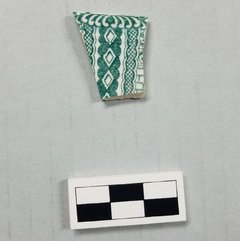This ceramic sherd was located during the excavation of an archaeological unit associated with the Long Barrack. The ceramic sherd is a type of refined white earthenware that was mass produced in both Europe and the United States. The decoration method lends to the name of the type.
After the initial throwing of the vessel, the potters would apply the decoration by stamping a tissue with the design applied in ink to the biscuit-hard vessel. The tissue would transfer the design the vessel. Then a clear glaze would be applied during the firing of the vessel, sealing in the design under the glaze. Typical designs included landscape scenes, buildings, and sometimes commemorate events.
Often the colors and designs used were to mimic Chinese porcelain. This sherd has a green transfer print on both the interior and exterior of the sherd.
Although the manufacture of this type of ceramic could have occurred during the late mission period, it is most likely that it was brought to San Antonio after the arrival of the railroad in the 1870s due to the greater ease of transporting the wares. Prior to the arrival of the railroad, similar items imported into San Antonio would have been expensive to obtain.



